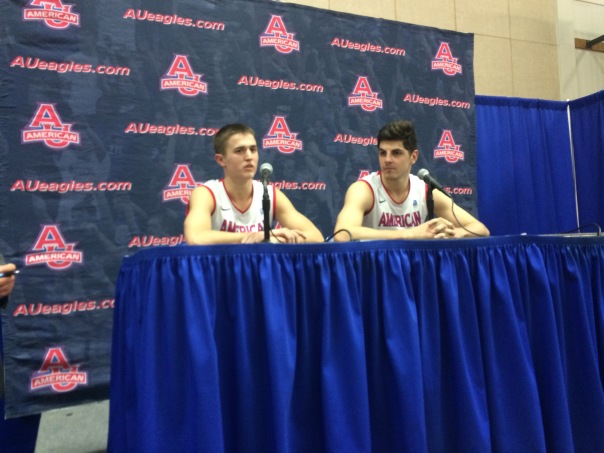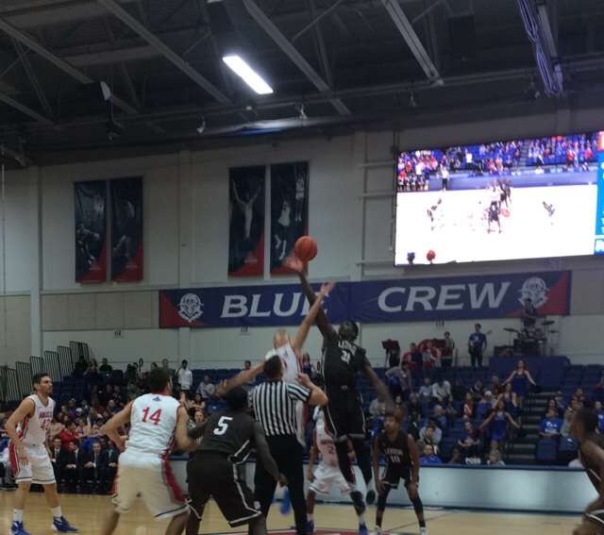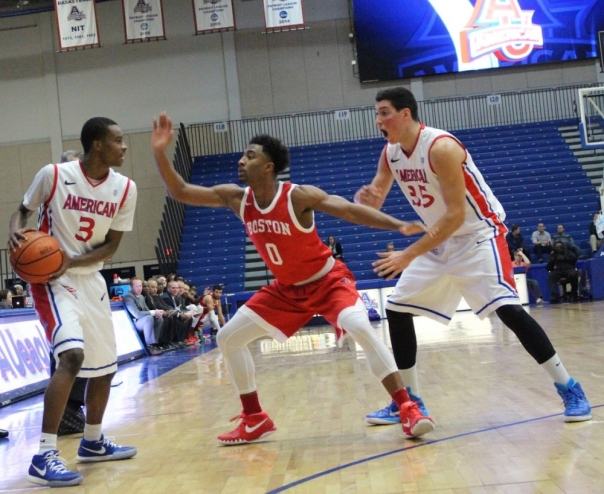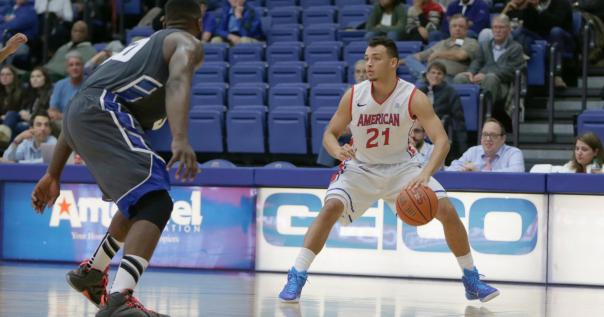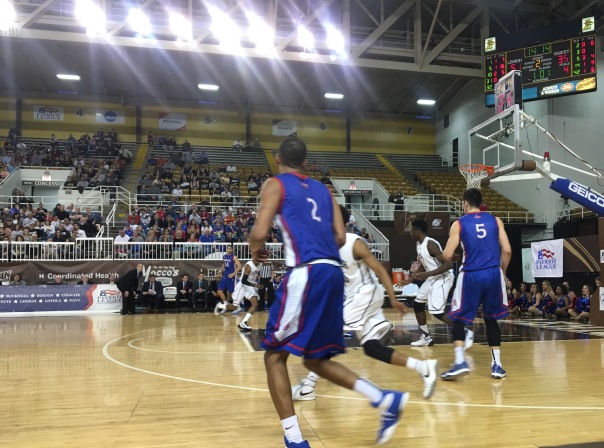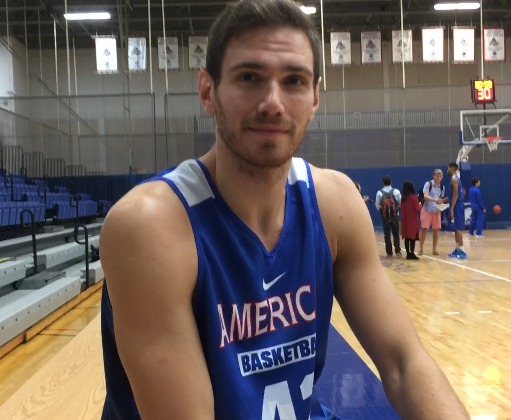
THE NUMBERS
Minutes
MPG: 14.9
% Minutes: 37.0
Offense
Points: 7.1 ppg
O-rating: 90.0
E-FG: 52.5%
Two-point shooting: 49.7%
3-point shooting: 52.9%
FT shooting: 69.8%
Turnover rate: 24.4%
Defense
Rebounding: 2.3 rpg
Defensive reb %: 14.7%
———————–
STRENGTHS
Midway through American’s season-opener at Rhode Island, fellow podcaster Sam, who was on press row in Kingston, RI, texted me with a prediction: Paris Maragkos, AU’s transfer from GW, would lead the Eagles in scoring for the season. I’m not writing this to throw Sam under the bus, as he was far from the only observer, myself included, who thought Paris would be a double-digit scorer and all-around threat for the Eagles. If only his first couple games in an Eagles uniform were a sign of things to come.
Against Rhode Island when most of the team looked shell-shocked, the freshmen unable to break a furious press, Maragkos played with poise and control, finishing with 16 points. He added 12 in the next game vs. Hampton. From the season’s outset, Maragkos showed an eagerness to be the guy to get AU’s offense going early in the game. He displayed an above-average ability to create space in the paint and get good enough position to receive an entry pass and then make a move toward the basket in a matter of seconds.
While Maragkos’ play and minutes in December trended toward increasingly unpredictable, he could still be considered one of the go-to guys for the Eagles heading into the Patriot League season. In the league opener at Loyola, the Eagles rode Maragkos to the tune of 17 points. Little did we know that night in Baltimore that he’d post just four more double-digit games in the remaining 19, but the end of this Mike Brennan quote after the Eagles’ loss on Dec. 30 perhaps portends this:
“He’s been working on being able to score down there. We’re trying to get the ball down to him. I don’t know if people will leave him alone like they did today, but it’s something that he’s worked on. He’s got to get some rebounds though.”
———————–
ROOM FOR IMPROVEMENT
Simply put, Maragkos was a decent scorer but not great — shooting 49% on twos is downright bad for a big man. As the season wore on, he did show an ability to hit the top-of-the-key 3 — an important skill for the 5 man in AU’s system — going 9-17 on the season.
What sent his playing time spiraling (Maragkos averaged just 12.4mpg in conference play including eight games in single digits) was a combination of three things (in order of what he struggled most with):
Rebounding
Passing
Defense
People might point to the defense first, but Maragkos actually showed signs of being able to decently defend especially in the post. He did an admirable job against Tim Kempton, including outplaying him and rendering the Lehigh big useless and in foul trouble in the teams’ first meeting. He wasn’t terrible against Nana Foulland either. Maragkos is slow laterally, and this cost him plenty in the foul column where he rarely got the benefit of the doubt on block-charge calls (especially compared to the quicker Marko Vasic).
Maragkos’ 5.8 fouls per 40 minutes would have ranked him second in the Patriot League behind only BU’s Nick Havener if Maragkos qualified (he didn’t play 40% of available minutes).
But as Brennan alluded to, rebounding was a bigger issue. The 6-9 Maragkos simply failed at the thing the undersized Eagles really needed, grabbing just 1.8 a game in conference play (tied for sixth on the team). Here’s Maragkos compared with other bigs in the league:
Defensive rebounding %
Tim Kempton, 27.4
Kevin Ferguson, 22.2
Nana Foulland, 19.4
Will Kelly, 17.1
Franz Rassman, 16.7
Paris Maragkos, 14.7
That list doesn’t include all the wings and guards that outrebounded Maragkos, too, including several on his team. It was easy to see that one of the biggest issues that plagued AU during its horrendous 10-game losing streak and 2-16 start was rebounding, and when things started to turn around, Vasic and Andrija Matic were seeing more court time and grabbing more boards.
Finally, as the season wore on, it became clearer that passing into Maragkos was throwing the ball into a dark hole. Sometimes he’d finish the running jump hooks that were his offensive staple all year, but what rarely occurred was a well-executed pass. When Maragkos was on the floor, he took 32.7% of the Eagles’ shots. That would rank him 26th … in the nation! That’s really poor for a player whose 2-point shooting percentage would have ranked him 29th in the Patriot League among eligible players.
It’s made worse by the fact that what happened to the offense when he received entry passes is the antithesis of what Mike Brennan is trying to do in the Princeton offense. The ball stopped moving, the team losing its flow. Maragkos’ assist to turnover rate (19.5 to 24.4) is also not flattering.
If Maragkos is going to see the floor consistently in 2016-17, rebounding and passing need to be priorities.
———————–
GRADE: D+
———————–
QUOTABLE
“Paris has continued to work hard and improve. Tonight he got the opportunity to show what he does every day. It’s good for him to give us something.”
— Mike Brennan, Feb. 3, after Maragkos’ best all-around game of the season vs. Bucknell (11 pts, 3 reb, 2 steals, 2 assists)
———————–
QUICK TAKE
It was disappointing to see the early potential Maragkos showed dissipate into him hardly being a rotation player during AU’s best stretch of basketball, but no one on the roster had such clear weaknesses that opponents exposed. With that said, the opportunity is there for Maragkos to have a strong senior season and so is the potential (take that Bucknell game, for instance). While Matic seemingly has the inside track at the starting center position, it’s far from decided.
*Note: If recent transfer Matt Cimino is eligible in 2016-17 (still pending), Maragkos will have a much steeper hill to climb for consistent playing time.
If Maragkos can become a much better finisher around the rim, learn how to pass out of the Princeton sets, and make rebounding his mission this summer, he could be a solid 15-20 mpg role player who even avarages double-digit points as a senior.
